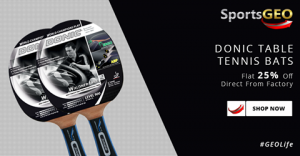A basic table tennis racket (has notions of being called a “paddle” or “bat”) is used by table tennis players. The table tennis racket is usually made from laminated wood covered with rubber on one or two sides depending on the player’s grip. Unlike a conventional “racket”, it does not include strings strung across an open frame.
 The racket may be of any size, shape or weight but the blade shall be flat and rigid. At least 85% of the blade by thickness shall be of natural wood; an adhesive layer within the blade may be reinforced with fibrous material such as carbon fibre, glass fibre or compressed paper, but shall not be thicker than 7.5% of the total thickness or 0.35mm, whichever is the smaller.
The racket may be of any size, shape or weight but the blade shall be flat and rigid. At least 85% of the blade by thickness shall be of natural wood; an adhesive layer within the blade may be reinforced with fibrous material such as carbon fibre, glass fibre or compressed paper, but shall not be thicker than 7.5% of the total thickness or 0.35mm, whichever is the smaller.
A side of the blade used for striking the ball shall be covered with either ordinary pimpled rubber, with pimples outwards having a total thickness including adhesive of not more than 2.0mm, or sandwich rubber, with pimples inwards or outwards, having a total thickness including adhesive of not more than 4.0mm.
Ordinary pimpled rubber is a single layer of non-cellular rubber, natural or synthetic, with pimples evenly distributed over its surface at a density of not less than 10 per cm² and not more than 30 per cm².
Sandwich rubber is a single layer of cellular rubber covered with a single outer layer of ordinary pimpled rubber, the thickness of the pimpled rubber not being more than 2.0mm.
The covering material shall extend up to but not beyond the limits of the blade, except that the part nearest the handle and gripped by the fingers may be left uncovered or covered with any material.
The blade, any layer within the blade and any layer of covering material or adhesive on a side used for striking the ball shall be continuous and of even thickness. The surface of the covering material on a side of the blade, or of a side of the blade if it is left uncovered, shall be matt, bright red on one side and black on the other. The racket covering shall be used without any physical, chemical or other treatment. Slight deviations from continuity of surface or uniformity of colour due to accidental damage or wear may be allowed provided that they do not significantly change the characteristics of the surface. Before the start of a match and whenever he or she changes his or her racket during a match a player shall show his or her opponent and the umpire the racket he or she is about to use and shall allow them to examine it.
Most Table Tennis equipment has remained relatively unchanged since the introduction of the sport. The racket (or bat, as is the common term) is an exception with the changes mainly the result of the development of different playing techniques and technology. Basic bats can be purchased for under INR 200. However, bats for top class play can cost in excess of INR 5,000.
These days, development is seeing the bat evolve into the current hi-tech product. Earlier, the bats were with 1 mm pimpled rubber sponge covered, but while this was suitable for all round play it did impose limitations on spin. The above was superseded by the 2mm pimple rubber bat which proved ideal for attacking play, but again limited spin. In terms of innovation, the next in line was a bat which was designed to counter topspin by providing a surface which would absorb heavy topspin. The maximum degree of spin and speed was produced by a bat which had a 1mm reverse rubber sponge surface. Finally, for greatest control, the 1mm reverse rubber sponge bat was produced.
These days, both sides of the blade are invariably covered with a layer of rubber and sponge. The nature of this combination influences the speed and spin which the user can impart onto the ball. Rubbers have various properties but are essentially of two types:
- a) Reversed (pimples in – smooth)
- b) Pimples out.
- For greater speed and/or spin a greater thickness of sponge is used.
